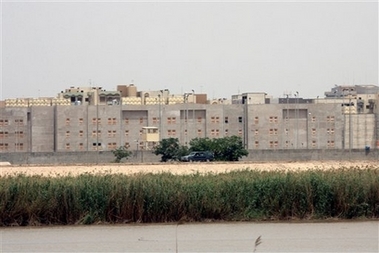美国大使馆将成为伊拉克之最
WASHINGTON - The new US Embassy in Baghdad will be the world's largest and most expensive foreign mission, though it may not be large enough or secure enough to cope with the chaos in Iraq.
 A portion of the new US embassy under construction is seen from across the Tigris river in Baghdad, Saturday, May 19, 2007. [AP] |
Over the long term, depending on which way the seesaw of sectarian division and grinding warfare teeters, the massive city-within-a-city could prove too enormous for the job of managing diminished US interests in Iraq.
The $592 million embassy occupies a chunk of prime real estate two-thirds the size of Washington's National Mall, with desk space for about 1,000 people behind high, blast-resistant walls. The compound is a symbol both of how much the United States has invested in Iraq and how the circumstances of its involvement are changing.
The embassy is one of the few major projects the administration has undertaken in Iraq that is on schedule and within budget. Still, not all has gone according to plan.
The 21-building complex on the Tigris River was envisioned three years ago partly as a headquarters for the democratic expansion in the Middle East that President Bush identified as the organizing principle for foreign policy in his second term.
The complex quickly could become a white elephant if the US scales back its presence and ambitions in Iraq. Although the US probably will have forces in Iraq for years to come, it is not clear how much of the traditional work of diplomacy can proceed amid the violence and what the future holds for Iraq's government.
"What you have is a situation in which they are building an embassy without really thinking about what its functions are," said Edward Peck, a former top US diplomat in Iraq.
"What kind of embassy is it when everybody lives inside and it's blast-proof, and people are running around with helmets and crouching behind sandbags?"
The compound will have secure apartments for about 615 people. The comfortable but not opulent one-bedrooms have offered hope for State Department staff now doubled up in tinny trailers.
Morale is at an ebb among the embassy staff, most of whom rarely leave the heavily fortified Green Zone during their one-year tours in Iraq. The barricaded zone houses both the current, makeshift US Embassy and the new compound about a mile away. A recent string of mortar attacks has meant further restrictions.
On Saturday, three mortar shells or rockets slammed into a Green Zone compound where British Prime Minister Tony Blair was meeting with Iraqi leaders. The attack wounded one person. One round hit the British Embassy compound.
The new US ambassador, Ryan Crocker, is reviewing staffing and housing needs, and fielding complaints about any suggestion employees either double up again or live elsewhere.
"We do believe that the embassy compound was right-sized at the time that it was presented to the Congress," Secretary of State Condoleezza Rice told a Senate panel this month. "There have been some additional issues since that time. "
Rice's senior adviser on Iraq, David Satterfield, said the embassy is not disproportionately expensive and will serve US interests for years.
"We assume there will be a significant, enduring US presence in Iraq," Satterfield said.
The Baghdad Embassy will open in September and be fully staffed by the end of the year, Satterfield said. US diplomats will move from a dogeared Saddam Hussein-era palace they have occupied since shortly after the 2003 invasion, to the growing irritation of many Iraqis.
The International Crisis Group, a nongovernmental organization that seeks to prevent and resolve conflicts, has identified the complex as the world's largest embassy. The organization notes that the embassy is a sore point with Iraqis who are fed up with war, violence and roadblocks and chafing under the perception the US still calls the shots more than four years after Saddam's ouster.
The embassy also is a prime target.
The area around the construction site was hit with mortar fire this month. Other areas of the US-controlled Green Zone were hit on consecutive days last week.
The increase in mortar and rocket attacks on the Green Zone has raised concern, especially because they are occurring during a US-led security crackdown in Baghdad.
The embassy has ordered its staff to wear flak jackets and helmets while outdoors or in uNPRotected buildings. The order was issued one day after a rocket attack killed four Asian contractors in the Green Zone this month.
It is unclear who is responsible for the recent attacks. Some barrages came from Shiite-dominated areas in eastern Baghdad. But the Green Zone also is within range of Sunni militant strongholds to the south.
The State Department and Congress have tussled this year over a $50 million request for additional blast-resistant housing. The department says it did not anticipate needing so many fortified apartments when the embassy was in the planning stages three years ago and Iraq was a less violent place.
The new Democratic-controlled Congress has grumbled about the approximately $1 billion annual cost of embassy operations in Iraq and told the administration the embassy is overstaffed at roughly 1,000 regular employees. Add security contractors, locally hired staff and others and the number climbs to more than 4,000.
"This is another case where poor planning, skyrocketing costs and security concerns are colliding in the Bush administration's policies in Iraq, and we need to make adjustments," said Sen. Patrick Leahy, chairman of the Senate panel that pays for State Department operations.
"They want hundreds of additional embassy staff who they cannot safely house within the new embassy compound. It's time for a reality check," said Leahy, D-Vt.




 手机网站
手机网站